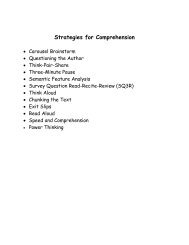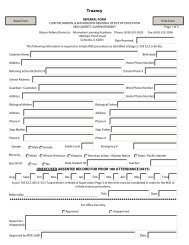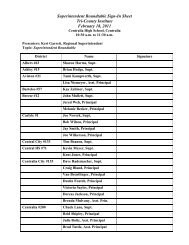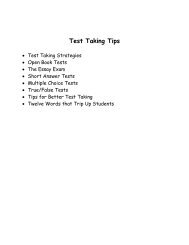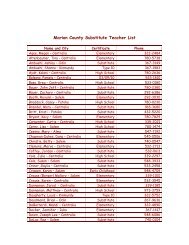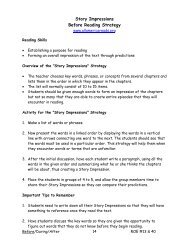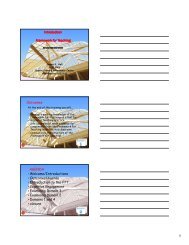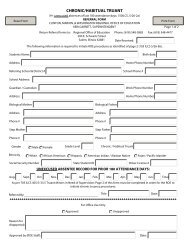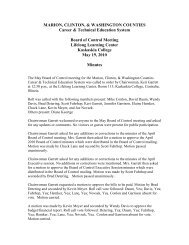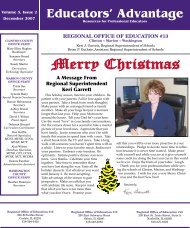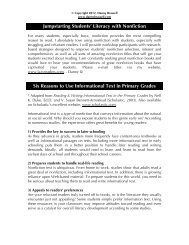Math Labs and Learning Stations - ROE #13
Math Labs and Learning Stations - ROE #13
Math Labs and Learning Stations - ROE #13
You also want an ePaper? Increase the reach of your titles
YUMPU automatically turns print PDFs into web optimized ePapers that Google loves.
<strong>Math</strong> <strong>Labs</strong> <strong>and</strong> <strong>Learning</strong> <strong>Stations</strong>Carol Hynes, Leominster, MAStaff Development for EducatorsSession Outline:1. Introducing math labs in middle school <strong>and</strong> high school math classesa. Why we startedb. How using centers <strong>and</strong> stations became a district-wide initiative2. Strategy for:a. checking for prior knowledgeb. practicing newly learned skillsc. reviewing/preparing for classroom, district, <strong>and</strong> state assessments3. Centers <strong>and</strong> <strong>Stations</strong> in the classrooma. Teacher’s role <strong>and</strong> responsibilitiesb. Student’s roles <strong>and</strong> responsibilitiesc. Focus on state <strong>and</strong> national st<strong>and</strong>ardsd. Address a variety of audiences for multiple purposese. Planning <strong>and</strong> preparing a lesson—in generalf. Let’s look at the L-I-N-E-A-R Lab4. Questions for Reflection about using centers/stations:a. How can you get started using them right away?b. How can you avoid classroom management problems?c. How can you assess student work?5. Sources for <strong>Math</strong> <strong>Labs</strong> <strong>and</strong> <strong>Learning</strong> <strong>Stations</strong>a. St<strong>and</strong>ards-based math programsb. State assessment testsc. Supplementary books <strong>and</strong> journals
1. INTRODUCING MATH LABS:a. Why we started: Desire to turn classroom learning into studentbasedrather than teacher-lead.b. How using centers <strong>and</strong> stations became a district-wideinitiative: We met as <strong>Math</strong> Vertical Teams monthly over a number ofyears. During those meetings we shared many strategies, including usingthe centers <strong>and</strong> stations in math class. Each month, we return withsamples of what we’ve tried <strong>and</strong> share samples of students’ work toanalyze <strong>and</strong> plan lessons <strong>and</strong> assessments.2. STRATEGY FOR:a. Checking for prior knowledge from a previous course or unit—provides an opportunity for students to show what they know <strong>and</strong> can do<strong>and</strong> provides an opportunity for teachers to prepare <strong>and</strong> revise plansbased on what students knowb. Practicing newly learned skills <strong>and</strong> concepts in a student-centered1-2 class period carousel activity— the physical movement around theroom also helps students be active, h<strong>and</strong>-on learnersc. Reviewing/Preparing for classroom, district <strong>and</strong> stateassessments—encourages students to review, determine what theyknow <strong>and</strong> what they need to work on. Helps to de-stress students in a“high-stakes” testing environment.
apply, <strong>and</strong> translate among mathematical representations to solve problems. Use representations to model <strong>and</strong> interpret physical, social, Select,mathematical phenomena. <strong>and</strong>3. CENTERS AND STATIONS IN THE CLASSROOMa. Teacher’s role <strong>and</strong> responsibilities: Creates a lab with multiple stations Creates a recording sheet Establishes ground rules Visit with groups during lab Checks group work, provides assistance, <strong>and</strong> signs-off on stationsb. Student’s role <strong>and</strong> responsibilities: Work with partner(s); visit the stations, complete the math work Check with the teacher before moving on to another station,correcting minor errors as needed. At times, provide help or get help from another group for aparticular station.c. Focus on State <strong>and</strong> National St<strong>and</strong>ards Our labs address all str<strong>and</strong>s from our state st<strong>and</strong>ards <strong>and</strong> theCommunicationNCTM Principles <strong>and</strong> St<strong>and</strong>ards across multiple grade levels. We especially focus on the NCTM st<strong>and</strong>ards of Communication,Connections, <strong>and</strong> Representation.ConnectionsRepresentationtheir mathematical thinking coherently <strong>and</strong> clearly to peers, teachers, <strong>and</strong> others. Recognize <strong>and</strong> use connections among mathematical ideas Communicate<strong>and</strong> use representations to organize, record, <strong>and</strong> communicate mathematical ideas. Create
L-I-N-E-A-R EQUATIONS STATION LABName(s)____________________________________________________Class ___________________________Date _____________________Your goal is to visit each of the 6 lettered stations of the L-I-N-E-A-R LEquationslab in any order with your partner(s), completing the work given there. Checkyour work for each station with the teacher/answer key. It is important that youget this lab sheet initialed by the teacher before moving on to the next station.StationTeacher’sInitials/CommentsLINEARLabCompleted
The directions for each station of the L-I-N-E-A-R Lab are given in the framesbelow. The actual problems will be posted at each station.STATION LFor the given graph, find the slope, y-intercept,<strong>and</strong> write the equation for each line.STATION ICut out the given graphs <strong>and</strong> sort them according to rate of change(slope):negative, zero, <strong>and</strong> positive.STATION NUsing each of the three marker boards provided, graph <strong>and</strong> writeequations to satisfy the conditions given for each.STATION EComplete the link sheet to represent the information in multiple ways.STATION AUse your graphing calculator to reproduce the pattern formed bylinear equations displayed at the station.STATION RFor each of the 4 graph cards (G1—G4) given, match the graph withits equation, table of values, slope <strong>and</strong> y-intercept.
4. QUESTIONS FOR REFLECTION ABOUT USING CENTERSAND STATIONSLet’s finish up by reflecting <strong>and</strong> strategizing about each question:a. How can you get started using them right away?b. How can you avoid classroom management problems?c. How can you assess student work?5. RESOURCES AND REFERENCESa. <strong>Math</strong> programs, especially st<strong>and</strong>ards-based ones such asEveryday <strong>Math</strong>, Connected <strong>Math</strong>, CorePlusb. State assessment tests—Questions are released each year. Wehave created complete math labs by using our state’s releaseditems, using appropriate grade level questions as is, or modified fora specific purpose.c. NCTM Journals <strong>and</strong> Illuminations WebsiteMiddle: <strong>Math</strong>ematics Teachingin the Middle SchoolHigh School: <strong>Math</strong>ematics Teacher
“Using <strong>Math</strong> <strong>Labs</strong> & <strong>Learning</strong> <strong>Stations</strong>”PRESENTED BY STAFF DEVELOPMENT FOR EDUCATORS (SDE)CAROL HYNESMATH MATERIALS WEB SITEThe University of Massachusetts Medical School Regional ScienceResource Center (RSRC) has agreed to host our <strong>Math</strong> CD on its web site.Directions for downloading the CD on the web address for RSRC:http://www.umassmed.edu/<strong>Math</strong>GraphicOrganizers.aspx?linkidentifier=id&itemid=49072Or use this shortcut: www.tinyurl.com/carolhynesmathThese will link you to the University of Massachusetts Regional Science ResourceCenter Curriculum Library. Follow the <strong>Math</strong> Graphic Organizers Link. You will beprompted to Open or Save the zipfile. Our recommendation is to save it to yourdesktop.Once downloaded <strong>and</strong> opened, you will find 2 folders:Elem-Pre-CalcCalculusThese folders contain hundred of files of graphic organizers, warm-up activities,math labs <strong>and</strong> more in multiple formats: Microsoft Word, PowerPoint, PDF, <strong>and</strong>jpeg pictures.REFERENCES:NCTM, (2001). The Roles of Representation in School <strong>Math</strong>ematics (2001 Yearbook).Reston, VA: National Council of Teachers of <strong>Math</strong>ematics.LABS:Barbie Bungee available at NCTM, website:http://illuminations.nctm.org/Spaghetti <strong>and</strong> Marbles available at University of Florida website:http://www.gatortrax.eng.ufl.edu/projects/Spaghetti%20And%20Marbles.docM & M Growth <strong>and</strong> Decay Labhttp://jbryniczka.weebly.com/uploads/4/0/9/1/4091055/mmactivity_10.pdf



